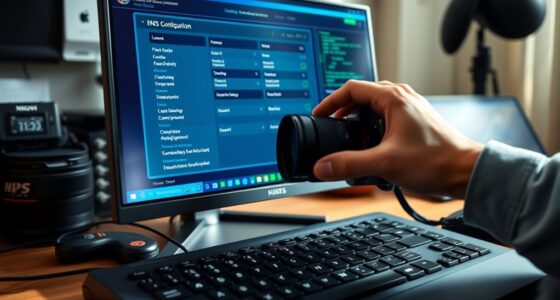To schedule cron jobs safely on a VPS and avoid the midnight surprise, you should explicitly set the time zone within your cron environment, ideally using the `TZ` variable or server configuration. Use absolute paths for commands, incorporate error handling and logging, and verify your schedules thoroughly. Monitoring job outputs helps catch issues early. For more detailed strategies and best practices, explore how proper time zone management and error handling can guarantee reliable automation around midnight.
Key Takeaways
- Explicitly set the server’s time zone to UTC to ensure consistent scheduling regardless of geographic location.
- Specify the desired time zone within each cron job using the `TZ` environment variable.
- Use absolute paths for commands and scripts to prevent environment-related execution issues.
- Redirect output and errors to logs for monitoring and troubleshooting cron job execution.
- Regularly review cron schedules and logs to detect and correct unexpected run times or failures.

Scheduling cron jobs on a VPS allows you to automate routine tasks, guaranteeing they run reliably at specified times. However, if you don’t pay attention to details like time zone management, you might find your jobs executing at unexpected hours—like the dreaded midnight surprise. To prevent this, you need to understand how your VPS handles time zones and set up your cron jobs accordingly. By default, cron uses the server’s local time zone, which can differ from your own or the time zone relevant to your application. This discrepancy can cause tasks to run at unintended times, especially if the server is hosted in a different geographic region. To avoid confusion, it’s best to explicitly set the time zone in your cron environment or specify the time zone in the cron job command itself. Alternatively, you can configure your server globally to use a specific time zone, such as UTC, which is often recommended for consistency across servers and applications.
Along with managing time zones, implementing robust error handling strategies is vital. When your cron jobs fail or encounter errors, silent failures can lead to data inconsistency or missed deadlines. To mitigate this, you should capture output and errors by redirecting them to log files. For example, appending `>> /var/log/mycron.log 2>&1` to your cron command ensures you record both standard output and errors, giving you visibility into what went wrong. You can also set up email notifications for failures if your server supports it, alerting you immediately when something’s amiss. Furthermore, testing your cron jobs thoroughly before deploying them helps catch potential issues early, reducing the risk of unexpected failures. Incorporating retry mechanisms into your scripts can further improve resilience, allowing tasks to attempt reruns if they encounter temporary errors. Additionally, understanding how cron manages environment variables can help prevent unexpected behavior caused by missing or misconfigured settings.
Finally, always remember to keep your cron syntax clear and precise. Use absolute paths for commands and scripts to avoid issues caused by environment differences. Regularly review your scheduled tasks and logs to guarantee everything runs smoothly and on time. By paying close attention to time zone management and error handling strategies, you’ll guarantee your cron jobs execute reliably without surprises at midnight or any other time you’ve designated. Proper setup and ongoing monitoring not only save you time but also safeguard the integrity of your automated processes, letting you focus on more vital aspects of your work.
Frequently Asked Questions
How Do I Troubleshoot Failed Cron Jobs Effectively?
When troubleshooting failed cron jobs, start by checking error logs for clues on what went wrong. Make certain your cron job is correctly set up and has the right permissions. Set up email notifications to alert you immediately of any failures. Review the logs and emails regularly, and test your scripts manually to confirm they work outside the scheduled environment. This proactive approach helps you identify and fix issues quickly.
Can I Run Cron Jobs With Different User Privileges?
Yes, you can run cron jobs with different user privileges by editing each user’s crontab, ensuring they have appropriate cron security measures. This setup allows you to assign specific privileges, minimizing security risks. Just remember, running jobs with higher privileges can be risky, so always follow best practices. Properly managing user privileges helps prevent unauthorized access, keeping your cron environment secure and efficient.
What Are Best Practices for Cron Job Security?
You’re walking a tightrope when it comes to cron job security, so it’s essential to follow best practices. Set strict cron permissions to limit access, ensuring only trusted users can edit or execute jobs. Use least privilege principles, run jobs under specific user accounts, and avoid using root unless absolutely necessary. Regularly update your system and monitor cron logs, because a stitch in time saves nine.
How Do I Handle Timezone Differences in Cron Scheduling?
To handle timezone differences in cron scheduling, you need effective timezone management. First, set your server’s timezone correctly, and consider using UTC to avoid complications caused by daylight saving changes. Alternatively, specify timezones explicitly in your scripts or use environment variables. This way, your cron jobs run consistently regardless of daylight saving shifts, preventing unexpected execution times and ensuring reliable scheduling across different regions.
Is It Possible to Run Cron Jobs Remotely?
Yes, you can run cron jobs remotely. To do this, you typically set up secure access, like SSH, to connect to your VPS. Using remote execution tools, you can trigger cron jobs from your local machine or another server. Just guarantee you have proper security measures in place, such as SSH keys and limited permissions, to keep your system safe while managing cron tasks remotely.
Conclusion
To truly avoid the midnight surprise, always test your cron jobs thoroughly and consider time zone differences. Some experts believe that scheduling jobs close to server reset times can prevent unexpected errors, but others argue that modern VPS systems handle these shifts smoothly if configured correctly. By understanding your server’s behavior and planning accordingly, you can schedule tasks confidently, ensuring they run reliably without unexpected midnight mishaps.









